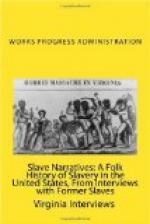“The plantation house was a large brick house over-looking the river from a hill, a porch on three sides, two-stories and attic. In the attic slept the house servants and coachman. We did not come in contact with the white people very much. Our place was away from the village.
“There were 8,000 acres to the plantation, with more than 150 slaves on it. I do not know the time slaves woke up, but everybody was at work at sunrise and worked to sundown. The slaves were whipped for not working fast or anything that suited the fancy of the master or overseer.
“I have seen slaves sold on the farm and I have seen slaves brought to the farm. The slaves were brought up the river in boats and unloaded at the landing, some crying and some seem to be happy.
“No one was taught to read or write. There was no church on the farm. No one was allowed to read the Bible or anything else.
“I have heard it said that the Randolph’s lost more slaves by running away than anyone in the county. The patrollers were many in the county; they would whip any colored person caught off the place after night. Whenever a man wanted to run away he would go with someone else, either from the farm or from some other farm, hiding in the swamps or along the river, making their way to some place where they thought would be safe, sometimes hiding on trains leaving Virginia.
“The slaves, after going to their quarters, cooked, rested or did what they wanted. Saturdays was no different from Monday.
“On Christmas morning all the slaves would go up to the porch, get the $2.50, shoes and clothes, go back to the cabins and do what they wanted.
“On New Year’s Day everybody was scared as that was the day that slaves were taken away or brought to the farm.
“You have asked about stories, I will tell you one I know. It is true.
“During the war one day some Union soldiers came to the farm looking for Rebels. There were a number of them in the woods near the landing; they had come across the river in boats. At night while the Union soldiers were at the landing, they were fired on by the Rebels. The Union soldiers went after them, killed ten, caught I think six and some were drowned in the river. Among the six was the overseer, and from that night people have heard shooting and seen soldiers. One night many years after the Civil War, while visiting a friend who now lives within 500 feet from the landing where the fighting took place, there appeared some soldiers carrying a man out of the woods whom I recognized as being the overseer. He had been seen hundreds of times by other people. White people will tell you the same thing. I will tell you for sure this is true.
“You must excuse me I wanted to see some friends this evening.”
Maryland 9/14/37 Guthrie
Phillip Johnson, An Ex-Slave.
Ref: Phillip Johnson, R.F.D. Poolesville,
Md.




